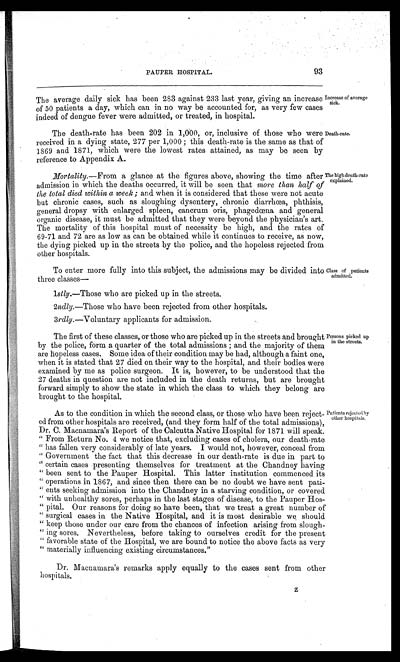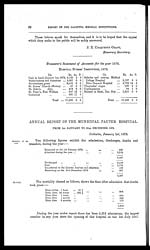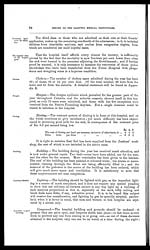Medicine - Institutions > Reports from medical colleges, schools and research institutions > Report on the Calcutta medical institutions > Calcutta medical institutions reports 1871-78 > Report on the Calcutta Medical Institutions for the year 1872
(197) Page 93
Download files
Individual page:
Thumbnail gallery: Grid view | List view

PAUPER HOSPITAL.
93
The average daily sick has been 283 against 233 last year, giving an increase
of 50 patients a day, which can in no way be accounted for, as very few cases
indeed of dengue fever were admitted, or treated, in hospital.
Increase of average
sick.
The death-rate has been 202 in 1,000, or, inclusive of those who were
received in a dying state, 277 per 1,000; this death-rate is the same as that of
1869 and 1871, which were the lowest rates attained, as may be seen by
reference to Appendix A.
Death-rate.
Mortality.—From a glance at the figures above, showing the time after
admission in which the deaths occurred, it will be seen that more than half of
the total died within a week; and when it is considered that these were not acute
but chronic cases, such as sloughing dysentery, chronic diarrhœa, phthisis,
general dropsy with enlarged spleen, cancrum oris, phagedœna and general
organic disease, it must be admitted that they were beyond the physician's art.
The mortality of this hospital must of necessity be high, and the rates of
69-71 and 72 are as low as can be obtained while it continues to receive, as now,
the dying picked up in the streets by the police, and the hopeless rejected from
other hospitals.
The high death-rate
explained.
To enter more fully into this subject, the admissions may be divided into
three classes—
Class of patients
admitted.
1stly.—Those who are picked up in the streets.
2ndly.—Those who have been rejected from other hospitals
3rdly.—Voluntary applicants for admission.
The first of these classes, or those who are picked up in the streets and brought
by the police, form a quarter of the total admissions; and the majority of them
are hopeless cases. Some idea of their condition may be had, although a faint one,
when it is stated that 27 died on their way to the hospital, and their bodies were
examined by me as police surgeon. It is, however, to be understood that the
27 deaths in question are not included in the death returns, but are brought
forward simply to show the state in which the class to which they belong are
brought to the hospital.
Persons picked up
in the streets.
As to the condition in which the second class, or those who have been reject-
ed from other hospitals are received, (and they form half of the total admissions),
Dr. C. Macnamara's Report of the Calcutta Native Hospital for 1871 will speak.
" From Return No. 4 we notice that, excluding cases of cholera, our death-rate
" has fallen very considerably of late years. I would not, however, conceal from
" Government the fact that this decrease in our death-rate is due in part to
" certain cases presenting themselves for treatment at the Chandney having
" been sent to the Pauper Hospital. This latter institution commenced its
" operations in 1867, and since then there can be no doubt we have sent pati-
" ents seeking admission into the Chandney in a starving condition, or covered
" with unhealthy sores, perhaps in the last stages of disease, to the Pauper Hos-
" pital. Our reasons for doing so have been, that we treat a great number of
" surgical cases in the Native Hospital, and it is most desirable we should
" keep those under our care from the chances of infection arising from slough-
" ing sores. Nevertheless, before taking to ourselves credit for the present
" favorable state of the Hospital, we are bound to notice the above facts as very
" materially influencing existing circumstances."
Patients rejected by
other hospitals.
Dr. Macnamara's remarks apply equally to the cases sent from other
hospitals.
Z
Set display mode to: Large image | Zoom image | Transcription
Images and transcriptions on this page, including medium image downloads, may be used under the Creative Commons Attribution 4.0 International Licence unless otherwise stated. ![]()
| Permanent URL | https://digital.nls.uk/74973467 |
|---|
| Description | 13 titles. Describes research work and conditions, treatments, vaccine production, medical education, public health and disease outbreaks. Extensive tables show mortality rates and patient admissions. These - some from asylums, jails, dispensaries, civil and police hospitals – will be useful to epidemiologists. |
|---|




